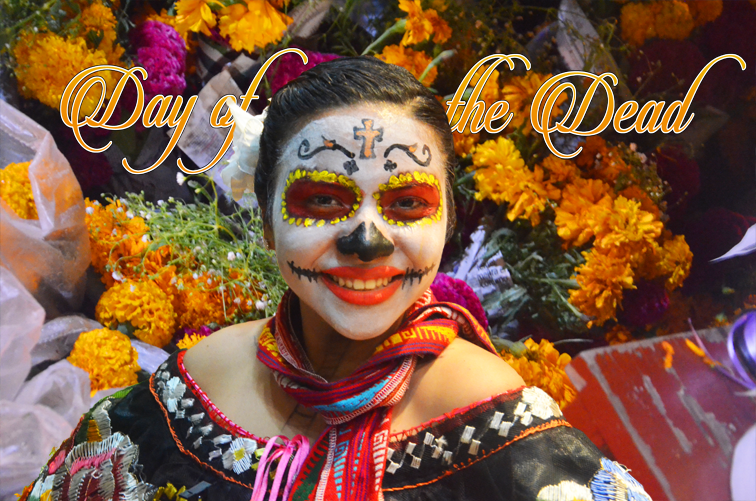photos of Mexican skulls and wondered what’s up with that? Well, now I’m just going to tell you a little.
It’s been going on for thousands of years. Origins of the celebration started with the Aztec, Toltec and other Nahua people who considered death just a part of the cycle of life. However, the dead in these societies were not considered dead and gone. They were still a part of the community and kept alive in memory and spirit. And, it gets a little more special (or eerie, depending on how you look at it). On the Day of the Dead, these not so long lost family members come back to Earth, temporarily. If you happen to be in Mexico in early November, you can expect a holiday that is a combination of pre-Hispanic religious rights, Christian feasts imported by the Spanish and now (sad to say) Halloween is also tossed into the mix. But, UNESCO has added the celebration to its list of Intangible Cultural Heritage of Humanity.
I’d witnessed a lot of things related to the celebration without really knowing what I was looking at. A little research is such an easy and wonderful thing. And, when food is involved, it’s even better. Yes, there is food that is traditional with the celebration.
First of all, there is pan del muerto. That’s bread of the dead. According to research, it often is sprinkled with anise seeds and decorated with bones and skulls. Sometimes the bones form a circle, for the circle of life. Unfortunately, Playa del Carmen really isn’t one of the centers in Mexico that wildly celebrates Día de los Muertos. There were no anise seeds (which I love). There were no clever bones or skulls on my bread. But, it was definitely sweet bread. The bun was sprinkled with sugar just like a donut. And, donuts are one of my favorite forms of sugar.
The last “must experience” item was a selection of a few fermented drinks. I really didn’t know where to find them, but I didn’t suffer. I ducked into an ice cream shop in the middle of downpour. Obviously, I was forced to eat ice cream. But, it was ice cream on Fifth Avenue. Two rather humble scoops of very delicious ice cream cost over five dollars! I’d say I lost for a second time.
Several shops that I visited had decorated alters. They are also in private homes and cemeteries, or so I’m told. The “ofrenda”s are not meant for worship. They are meant to welcome the spirits back. There may be incense, candles, photos of the departed, water, sweet bread, a healthy dose of yellow marigolds, and a colorful supply of papel picado (tissue paper punched into creative designs with hammer and chisel). One of the more interesting offerings I saw included sugar cane. I plan to still have a sweet tooth if I ever come back for this holiday.
I was informed that if I wanted to see a real celebration, I needed to go to Xcaret. (A little F.Y.l. here, this time the “x” sounds like “ish”. There is no constant rule for what an “x” sounds like in Spanish.) Xcaret is a theme park near Playa del Carmen. It’s not a Disney wanna-be. It costs more than Disneyland! Entrance to the park was ONE HUNDRED DOLLARS! That is just simply absurd. I refused to celebrate Día de los Muertos by throwing away that kind of money.
ANYWAY, as I painted my mural, I asked a couple of people about traditions for Día de los Muertos in their families. Was this a time for a fiesta in the community? or was this a time for the family at home? Both people told me it was a family occasion. Next question, what kind of food is served? Tamales. Is there ever a bad time for tamales? Is there ever an occasion when you shouldn’t bring a gringo home for tamales? I guess the answer to that question is Día de los Muertos.
There was no invitation.
So, in Playa, it was a calm and relaxing Day of the Dead. As I strolled home from the market, a mother and her two young children were dressed up for the celebration. The little girl was a princess. It doesn’t matter the country or the celebration, little girls love to be princesses. She had sneakers that lit up with her every step. I assume she was on her way to her grandmother’s home. And, she walked like a little girl, sparkling with every step.
As for her brother, he held on tightly to a fresh bouquet of the celebration’s traditional yellow marigolds, again I assume for grandmother. And, as he walked down the street, around and through puddles of water, he walked just like a little boy, leaving scattered marigolds in his path.





 RSS Feed
RSS Feed